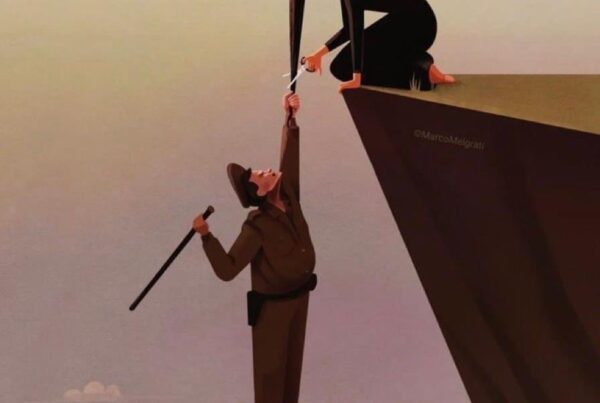
By Mina Khanlarzadeh
The recent street protests in Iran are globally associated with the name of Jina (Masha) Amini, a female Kurdish Iranian who was killed by Iran’s morality police on 16 September 2022, and also with the slogan zan, zendegi, azadi — Woman, Life, Freedom. To interpret these protests, some commentators have started with Iranian women’s protest against compulsory hijab on International Women’s Day, March 8th, 1979, right after the 1979 Revolution. Others have mentioned the Green Movement in 2009, or the more recent workers’ protests that used the slogan nan, kar, azadi (bread, labor, freedom). In fact, a video in honor of the recent protests mentions both slogans and ties them to each other. Some others have pointed to the Girls of Enghelab Street protests, who have been challenging mandatory hijab since 2017 by standing out in public and waving their scarves like flags of their protest for gender justice and against the state’s patriarchal oppression.[1]
For this particular analysis, I start with the mandatory unveiling that occurred under Reza Shah Pahlavi from 1936 until 1941. Mandatory unveiling was part of the Reza Shah’s government’s project to Westernize Iranian society. This autocratic modernization policy limited the mobility of women who did not wish to be seen unveiled in public. If they needed to venture out, such women needed to sneak along the roofs to avoid being seen, while one report describes them being camouflaged in a sack as pistachios to be carried to their destination by their male relatives.[2] In order for the nation to pass as Europeanized, these veiled women had to be concealed from view. As such, women’s attire essentially became the attire of the nation itself. After the abdication of Reza Shah in 1941, the fundamentalist Islamists known as the Devotees of Islam, as well as conservative clerics, attempted to mandate the wearing of the hijab but failed. [3]
Reza Shah’s son and successor, Mohammad Reza Pahlavi’s government treated Westernization as interchangeable with modernization. During this time (1941–1979), while women had the social freedom to choose to wear the hijab or not, the hijab continued to signify as pre-modern and even “backwards.” Two main camps were critiquing the Shah’s Westernization projects: those who perceived it as inherently out of tune with Muslim societies, and those who argued they did not allow for meaningful social transformation. One main reason the followers of these two camps formed an alliance and accepted the unified leadership of Ayatollah Khomeini, in the 1970s, was that gender was secondary in their thoughts, while anti-imperialism (just two decades after the US-UK–led 1953 coup) was central.[4] Also, both sides considered pleasure and leisure to be counter-revolutionary, one in the name of religious belief and the other in the name of revolution. [5]
It is helpful to learn intellectuals, in the 1960s and 70s, from the latter camp (the one who wished for meaningful transformations), such as Jalal Al-e Ahmad and Ali Shariati, expressed discontent with the state’s discourses and practices of Westernization, describing them as merely superficial. They proposed that attention should instead be paid to the particulars of Iran’s social history while remaining committed to industrialization and the political-economic development of the nation. In particular, Shariati discussed joining Eurocentric universalism (a universalism merely informed by Europeans’ social history) would turn Iranians into “natives,” (second class humans) on the global scene. To challenge Eurocentrism, Iranians were to develop a new social-political consciousness by de-alienating themselves from their particular social history.[6] This de-alienation, however, was not simply a return to traditions. Rather, informed by Martinique political philosopher Frantz Fanon’s ideas, it was focused on the formation of a new consciousness and humanity. [7] To Al-e Ahmad, in some instances, traditions were to be kept — he argued, for instance, that to escape what he called “westoxication,” intellectuals should join together with the conservative clerics. On the other hand, Shariati claimed that a commitment to past traditions would also result in alienation from the present historical moment and its specificities. Even Islam, in his view, had to be fully transformed and made contemporary.
It is essential to understand this context in order to make sense of the environment of the 1960s and 1970s, during which activists transformed the familiar into revolutionary concepts and challenged European supremacy. It is therefore no surprise that at this historical juncture some female political activists, particularly those who were Marxist-Islamists, wore the hijab to signifying resistance against the state discourses of Westernization.
In earlier decades, mandatory unveiling had turned the hijab into “the other” of modernity and progressiveness; now, its adoption by female activists who took political action alongside men dislodged the hijab from its past historical meaning and made it newly represent female political subjectivity and their challenge to Eurocentrism. Many female activists who adopted the hijab transgressed traditional values — instead of leading a conventional family life, they took up arms against the state, lived in underground safehouses, and spent years in prison. Thus, in the 1970s, among politically active women, the hijab represented resistance of the nation in the process of becoming revolutionary.
After the 1979 Revolution, members of the Islamic government were close to the Devotees of Islam, who had earlier demanded the hijab be made mandatory. The post-Revolution government turned nativism into their official rules and laws, and modernization became divorced from Westernization, at least discursively.[8] There is a belief that the adoption of the hijab by some pre-Revolution female activists was analogous to the rule of compulsory hijab established by the post-Revolution government. While it is important to investigate authoritarianism in the practices and thoughts of revolutionaries from various factions (such as the ones influenced by intellectuals such as Al-e Ahmad and Shariati) and observe the existing resemblances between them and post-Revolution government, painting the two as identical is an oversimplification. According to the Iranian state’s ideology, the mandatory hijab is legitimate in Iran since the country is a Muslim-majority nation and this, supposedly, is “what Muslims want.” In reality, the hijab is essential to the Islamic Republic of Iran because what the female body wears is, in fact, the clothes of the nation, which allows the country to pass as Islamized. Mandatory hijab is also a tool for random punishment and for the exertion of public control over the female bodies and their presence in public.
Over the past few years, some satellite TV channels began celebrating Reza Shah and Mohammad Reza Shah as the great reformers of the nation. This reemergence points to a valorization of Westernization over the Islamic republic’s patriarchal nativism and religious despotism. Thus, certain activists, mostly from outside Iran, and TV channels, such as Manoto TV, have showcased women wearing fashionable clothes in the years prior to the Revolution, suggesting that the dress of the female body represents the state of the nation under Mohammad Reza Shah: modern, stylish, and socially free.
To summarize: unveiling first represented Reza Shah’s Westernization of the nation, then it represented a Westernized and socially free nation during the reign of Mohammad Reza Shah while, simultaneously, hijab amongst some in the opposition groups symbolized the revolutionary movement that was resisting Eurocentrism; following the Revolution, women’s hijab was transformed into a representation of an absolutist Islamized republic. More recently, the unveiled woman again more recently was associated with modern as chic and socially free. These recent protests, however, are a turning point.
The ongoing protests in Iran seek to liberate the female body from the state’s nativist discourses and from the oppressive and patriarchal laws of the compulsory hijab, yet they do not suggest a replacement. Instead, the demand is for women’s clothing and fashion sensibilities to be liberated from their ties to the nation. The scarves women set on fire are their demand for an end to a history of various states’ regulation of their appearance — be it mandatory unveiling (Westernization) or compulsory hijab (Islamization). What is emerging instead, perhaps, is moving beyond Eurocentric Westernization and nativist relativism towards the formation of an inclusive universalism where Iranians would no longer be natives on the global scene. While some elements of this protest reflect some of the original ideals of the 1979 Revolution, it is also informed by the Revolution’s main shortcoming: the marginality of gender liberation and relegation of pleasure to a counter-productive, counter-revolutionary status. This is why gender justice is at the forefront of this current movement, and some of the joyful protest videos seem similar to the celebration of Charshanbeh Soori (Scarlet Wednesday), when the Iranian New Year celebration starts, than to street activism.
There is also an awareness that without addressing injustice against oppressed ethnic groups, there will be no gender justice for all women. In fact, it is possible that Mahsa Amini received harsher treatment from the morality police not only due to her resistance but because she was Kurdish. It is possible the officers imagined her death would receive less attention because of her ethnicity. The slogan Mahsa Amini Ma (Mahsa Amini, Us), with its consciousness of the ethnic plurality of the movement, is new.
Many of the protestors who have been killed in recent weeks were younger than 22 and are from a generation of youth who have met many of their friends on Twitter, Instagram, and TikTok. The state’s politics of location (its center versus peripheries), is much less present among them. There is hope that a new collective consciousness will emerge from this moment, one in which relations between various ethnic groups within Iran will become more equal and cooperative. This hope is not baseless. For perhaps the first time, the victims of the Islamic Republic killed in Balochistan have names and faces. And what seems to have instigated the idea that revolution is the solution is the collective pain at the loss of a young Kurdish woman, Mahsa Amini.
So far, the Western left has mostly ignored these protests, some with the justification that the protests seem generally Islamophobic. This is similar to considering protests against the abortion ban to be an offense against Christianity. The Western left’s discomfort might rather stem from a deeper concern: in this moment, Iranian women are no longer the object of protection against Western imperialism. They are heroes of a feminist movement that is neither against the West nor interested in copying it. They are sharing their unique and complex story to the world and are challenging their global audience to expand their social-political imagination.

[1]: A selection of the articles published on the recent street protests: Nahid Siamdoust, “Woman, Life, Liberty: A Slogan One Hundred Years in the Making” (link) Alborz Ghandehari, “Teachers and Other Unionists Are Joining Iran’s Gender Justice Uprising” (link)Ali Kadivar, “Are Iran’s hijab protests different from past protest waves?” (link) Narges Bajoghli, ““Woman, Life, Freedom”: Iran’S Protests Are A Rebellion For Bodily Autonomy” (link)
[2]: Chehabi, Houchang. “Staging the Emperor’s New Clothes: Dress Codes and Nation-Building under Reza Shah.” Iranian Studies, (1993), 26(3/4), 220–221. http://www.jstor.org/stable/4310854 . Also, see: Haideh Moghissi, Populism and Feminism in Iran, 37–57.
[3]: Hamideh Sedghi, “FEMINIST MOVEMENTS iii. IN THE PAHLAVI PERIOD,” Encyclopaedia Iranica, IX/5, pp. 492–498, available online at http://www.iranicaonline.org/articles/feminist-movements-iii (accessed on 2 September 2022.)
[4]: To learn more about factions involved in the 1979 Revolution and limitations of past historiographies, see: Sohrabi, N. (2018). The “Problem Space” of the historiography of the 1979 Iranian Revolution. History Compass, 16(11). https://doi.org/10.1111/hic3.12500
[5]: Naficy, Hamid. A Social History of Iranian Cinema, Volume 2, 150.
[6]: For more on de-alienation in political philosophy of Shariati, see: Khanlarzadeh, M. (2020) “Theology of revolution: In Ali Shari’ati and Walter Benjamin’s political thought,” Religions, 11(10), p. 504. Available at: https://doi.org/10.3390/rel11100504.
[7]: On the relation between Fanon’s ideas and Shariati’s, see: Davari, A. (2014). A return to which self? Comparative Studies of South Asia, Africa and the Middle East, 34(1), 86–105. https://doi.org/10.1215/1089201x-2648587
[8]: Naficy, Hamid. A Social History of Iranian Cinema, Volume 1, 195.


